
(a)
Interpretation:
The given carbon oxygen-containing compound has a carbonyl group or not has to be indicated.
Concept Introduction:
Carbonyl groups are the one which contain a double bond between carbon and oxygen atom.
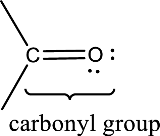
(a)
Answer to Problem 4.1EP
Carbonyl group is present in this compound.
Explanation of Solution
Given compound is,

In the above structure, a double bond is present between the carbon and oxygen atom. This is the carbonyl group.
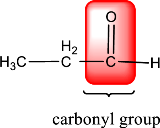
Therefore, the compound that is drawn above has a carbonyl group in its structure.
The given compound contains a carbonyl group in its structure.
(b)
Interpretation:
The given carbon oxygen-containing compound has a carbonyl group or not has to be indicated.
Concept Introduction:
Carbonyl groups are the one which contain a double bond between carbon and oxygen atom. Aldehydes and ketones possess this carbonyl functional group in it. The structural representation of a carbonyl group can be given as shown below,
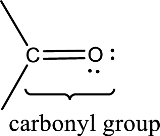
(b)
Answer to Problem 4.1EP
Carbonyl group is not present in this compound.
Explanation of Solution
Given compound is,

In the above structure, no double bond is present between the carbon and oxygen atom. Therefore, the compound that is given does not have a carbonyl group in its structure.
The given compound does not contain a carbonyl group in its structure.
(c)
Interpretation:
The given carbon oxygen-containing compound has a carbonyl group or not has to be indicated.
Concept Introduction:
Carbonyl groups are the one which contain a double bond between carbon and oxygen atom. Aldehydes and ketones possess this carbonyl functional group in it. The structural representation of a carbonyl group can be given as shown below,
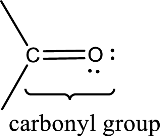
(c)
Answer to Problem 4.1EP
Carbonyl group is not present in this compound.
Explanation of Solution
Given compound is,

In the above structure, no double bond is present between the carbon and oxygen atom. Therefore, the compound that is given does not have a carbonyl group in its structure.
The given compound does not contain a carbonyl group in its structure.
(d)
Interpretation:
The given carbon oxygen-containing compound has a carbonyl group or not has to be indicated.
Concept Introduction:
Carbonyl groups are the one which contain a double bond between carbon and oxygen atom. Aldehydes and ketones possess this carbonyl functional group in it. The structural representation of a carbonyl group can be given as shown below,
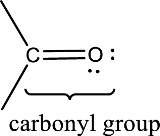
(d)
Answer to Problem 4.1EP
Carbonyl group is present in this compound.
Explanation of Solution
Given compound is,

In the above structure, a double bond is present between the carbon and oxygen atom. This is the carbonyl group.
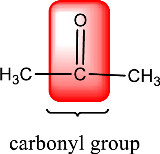
Therefore, the compound that is drawn above has a carbonyl group in its structure.
The given compound contains a carbonyl group in its structure.
Want to see more full solutions like this?
Chapter 4 Solutions
Organic And Biological Chemistry
- Organic compounds classified into different families. Which of the following family of organic compounds will have 5 carbons in the third member? O ketones O carboxylic acid O Ethers Estersarrow_forward4. Draw the line structure for the ester that can be formed from the reaction of the acid anhydride and the alcohol given below. :0: :0: HO CH3-CH2-C-o-C-CCH2-CH3 acid anhydride alcoholarrow_forwardFunctional Group Classes Alcohol Amide Ester • CH₂CH₂OH * CHIO-CH, 7. H₂C1O Amine Ketone Circle each functional group(s) and identify the class to which each of the groups belongs. 9. H₂C Aldehyde Thiol Aromatics Carboxylic Acid 2. CH,SH 6. Alkenes 4. H₂NCH₂CH₂ 10. Ether NM₂ 11. Which of the functional groups in the top list must be on a terminalC in the carbon chain?arrow_forward
- What is the type of bond in organic compounds? covalent bonds a polar bonds ionic bonds C d polar covalent bondsarrow_forwardWhich of the following is not a physical property of alcohols or phenols? A. The solubilities of primary alcohols in water decrease with increasing molecular weight. B. Due to hydrogen bonding, boiling points of alcohols is much higher than those of corresponding alkanes. C. The hydroxyl group of an alcohol is nonpolar. D. Phenols are generally only slightly soluble in water.arrow_forwardDefine the structure of a carboxylic acid ?arrow_forward
- 14 What type of organic molecule is this? ketone O alcohol aldehyde organic acid I- I- I-0–Iarrow_forwardPropanoic acid inhibits the growth of mold and some bacteria and is therefore used as a preservative for both animal feed and food for human consumption. H H H-C-CIC H H O 01H The structural diagram above represents CH₁ Organic Compounds a saturated an unsaturated compound that contains a carboxyl + functional group.arrow_forward1. Provide the IUPAC name for each of the following organic molecules. a. b. C. asa CH3 angala но. OH mogubias H H3C CH3arrow_forward
 ChemistryChemistryISBN:9781305957404Author:Steven S. Zumdahl, Susan A. Zumdahl, Donald J. DeCostePublisher:Cengage Learning
ChemistryChemistryISBN:9781305957404Author:Steven S. Zumdahl, Susan A. Zumdahl, Donald J. DeCostePublisher:Cengage Learning
 Chemistry: An Atoms First ApproachChemistryISBN:9781305079243Author:Steven S. Zumdahl, Susan A. ZumdahlPublisher:Cengage Learning
Chemistry: An Atoms First ApproachChemistryISBN:9781305079243Author:Steven S. Zumdahl, Susan A. ZumdahlPublisher:Cengage Learning
 World of Chemistry, 3rd editionChemistryISBN:9781133109655Author:Steven S. Zumdahl, Susan L. Zumdahl, Donald J. DeCostePublisher:Brooks / Cole / Cengage LearningChemistry: Matter and ChangeChemistryISBN:9780078746376Author:Dinah Zike, Laurel Dingrando, Nicholas Hainen, Cheryl WistromPublisher:Glencoe/McGraw-Hill School Pub Co
World of Chemistry, 3rd editionChemistryISBN:9781133109655Author:Steven S. Zumdahl, Susan L. Zumdahl, Donald J. DeCostePublisher:Brooks / Cole / Cengage LearningChemistry: Matter and ChangeChemistryISBN:9780078746376Author:Dinah Zike, Laurel Dingrando, Nicholas Hainen, Cheryl WistromPublisher:Glencoe/McGraw-Hill School Pub Co





